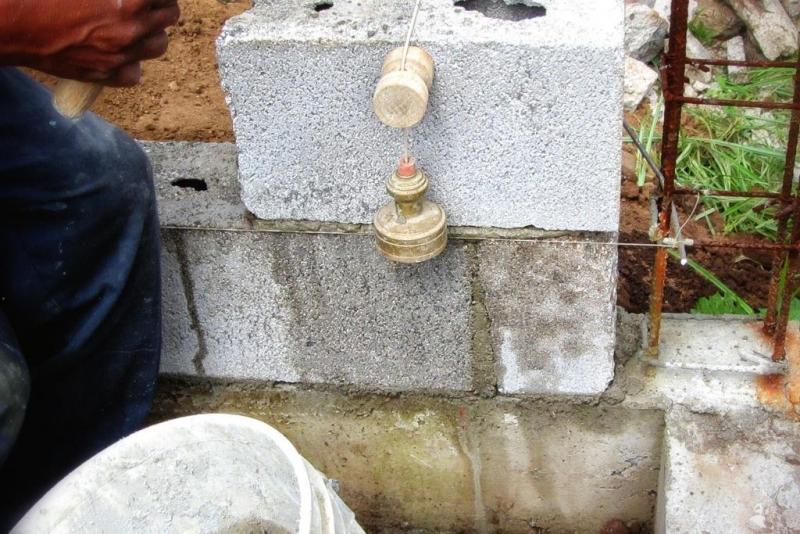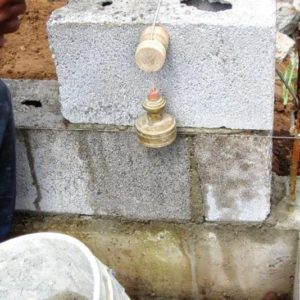Where can I find a Mason’s Plumb like this?
I was in Guatemala last week with a missions team and was taught to lay block by a really nice young mason, even though neither of us spoke the other’s language. He used the plumb pictured below, which I’ve never seen before. As an engineer and machinery alignment guy, I was blown away by it’s simplicity and accuracy.
Where can I get one? I’ve googled everything I could think of with no luck.





















Replies
To make a photo appear inside your message, you have to know a bit about HTML coding. Click on the "source" button at the top left of the reply window, then type your message using html. To load a photo on the page, the photo has to be somewhere accessible by anyone on the web (photo hosting site like Photobucket or Flickr, etc.). Then use the html code noted below:
<img src="url_of_photo_on_photosharing_site.jpg"> <p>
The photo should be reduced in size to no more than about 1000pixels across and/or 800 vertical. 800x600 is probably even better. When reducing the photo's size, adjust its compression so that the final photo file size is no more than about 400k (and that's overkill for a 1000x750 image).
have the photo saved on your computer and use the Browse button on the reply page to load a jpeg file.
Once it's loaded, open that link in a new window-copy the url. (or just copy the url that appears after it loads)
Then, go to the top row of stuff in the reply box-all the way to the right is the IMAGE button-and insert that FHB url.
Miracle of miracle-it's shown in the message.
View Image
or perhaps this?
.View Image
That's Bob???
Pot calling the kettle black buddy..............
That would be Plumb Brandy.
There's another model...............her name escapes me, but she is certainly not clothed.
The beauty of it is this is a precise pc of equipment.
No, it's "Bob"... but you
No, it's "Bob"... but you can't tell because "she's" wearing clothes.
Wrong again my friend..........
Brandy's her name-still have the clear acrylic tube that houses that beauty-her name printed right on the label.
And with boobs like that, the this waist...............you must be blind too.
So, you're saying you are better at spotting transgendered tools that I? Where in California do you live again? ;)
Thanks
I know what a plumb bob is.... and when you google that you get lots of hits. But I've still not found what is pictured. I didn't have a picture with the original post because - as I said - I was using an iPad and there is no way to "attach" a photo.
Never seen anything like that. Presumably the bottom is flat so that you can level the horizontal string against it?
(But it doesn't seem like a particularly good tool -- complicated to use and not particularly accurate. It's one big advantage would be that you could carry it in your pocket.)
"doesn't seem like a
"doesn't seem like a particularly good tool -- complicated to use and not particularly accurate"
Actually it's very easy to use, and much more accurate than anything I've ever seen for laying block. The "bottom" is not used at all. The "side" of the cylinder is used along with the spacer (wooden, hourglass). After the first course is laid, he uses a standard level to "rough in" an end block. Then he lowers the plumb-bob to the center of the block and adjusts the face of the block (by tapping on the top) until the side of the plumb-bob just touchs the surface. Now the block is perfectly plumb. Next he drops the plumb-down down to the middle of the bottom block (first course), and taps the top block in or out until it is perfectly true with the bottom course. The string slides through the spacer which makes raising or lowering the plumb-bob very easy, and the shape of the spacer makes it hands-off in use. Then he sets the corner block on the opposite end the same way, and then pulls a monfilament line for the string line (much more accurate than the nylon twine we use).
I assure you his walls are flatter and truer than anything you'd find here in the states.
Would be easy enough to make.
Yes, if you had a lathe and a large hunk of brass (the lower piece is solid brass). I'd make the spacer out of brass as well, and use a smaller line.
Or you could use a hollow bike axle, a bunch of fender washers, and maybe some nesting brass tubing (from a hobby shop) inside the bike axle to "smallify" the hole in the axle. A conical wood wedge in the bottom would secure the string.